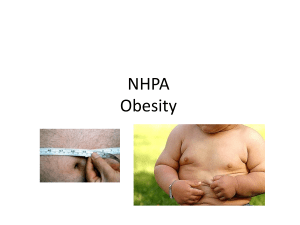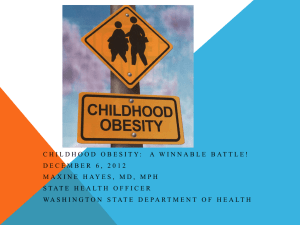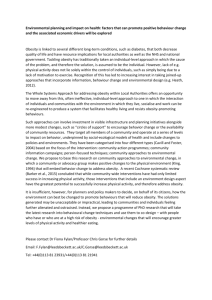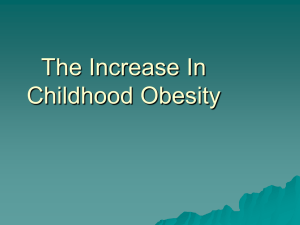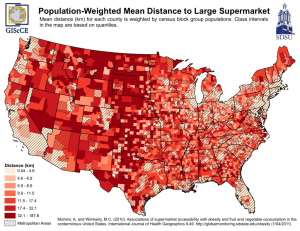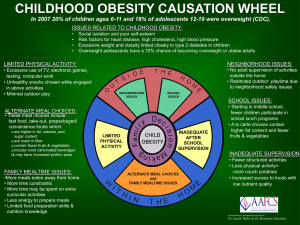File - Your Child's Health Matters
advertisement
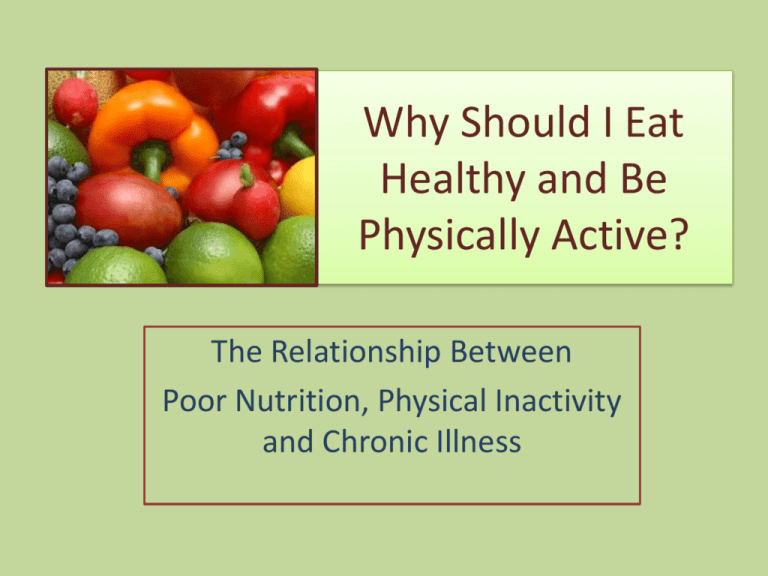
Why Should I Eat Healthy and Be Physically Active? The Relationship Between Poor Nutrition, Physical Inactivity and Chronic Illness Why Should You Learn About Healthy Nutrition and Physical Activity? • In our country, there is an epidemic of obesity and poor nutrition behaviors. • The obesity rate is doubling every 20 years. • Over 2/3 of Americans are either overweight or obese. • We are more sedentary in our lives today than ever before. • Many chronic diseases are preventable and are linked to poor nutrition and physical inactivity. Just as a person struggling with his or her weight needs to balance exercise and nutrition, the approach to obesity prevention and prevention of chronic diseases needs to be balanced by: •Choosing nutrient-dense foods •Remaining physically active throughout life •Balancing caloric intake with energy expenditure All of us must make healthy decisions each day in order to remain healthy throughout life! Now is the time to begin making good decisions not after chronic illness has negatively affected health… It is recommended that we have 60 minutes of physical activity each day. The childhood obesity epidemic is increasing . . . Obesity Trends* Among U.S. Adults BRFSS, 1990, 1999, 2009 (*BMI 30, or about 30 lbs. overweight for 5’4” person) 1999 1990 2009 No Data <10% 10%–14% 15%–19% 20%–24% 25%–29% ≥30% The childhood obesity rate is doubling every couple of decades . . . 29% were overweight or obese High School Data 52% are not active 60 min. (5 of 7 days) Youth Risk Behavior Survey 30% drank a can or bottle of soda or pop every day the past seven days Middle School Risk Behavior Survey 43% are trying to lose weight 41% are NOT active 60 minutes a day (5 of 7 days) 39% watched three or more hours of TV on an average school day Obesity is one of several illnesses associated with poor nutrition. Others include . . . oDiabetes oHigh blood oOsteoporosis pressure/Stroke oCardiovascular oAsthma diseases oSleep apnea oSome types of oDental caries cancers oDeficiency diseases oMetabolic such as rickets, syndrome anemia oOsteoarthritis oGallbladder/Liver In children, early onset of puberty is associated with obesity. Diseases Associated with Obesity Diabetes-Type 2 or adult onset diabetes is a chronic disease characterized by insulin deficiency. It can be developed later in life or in childhood in obese children. Type 2 differs from Type 1, juvenile onset diabetes, which is caused when the pancreas in a child does not produce insulin, and is not linked to obesity. Osteoporosis-Honeycombing of the bones. Weakened bones caused by insufficient calcium absorption, characterized by the bones breaking easily. Diseases Associated with Obesity (continued) Cardiovascular diseases-Any of the many diseases of the heart and blood vessels, such as arteriosclerosis which is a chronic disease characterized by the thickening and hardening of arterial walls. Cancer-Obesity is associated with increased risks of the following cancer types: esophagus, pancreas, colon, rectum, breast, uterus, kidney and thyroid. Metabolic syndrome-Group of risk factors that occur together and increase the risk of coronary artery disease, stroke and type 2 diabetes. Diseases Associated with Obesity (continued) • Osteoarthritis-Degenerative joint disease. • High blood pressure-Abnormally high arterial blood flow. (hypertension) • Asthma- A chronic respiratory disease accompanied by labored breathing. • Sleep apnea-Stopping breathing while asleep. • Dental caries-Tooth decay. Diseases Associated with Obesity (continued) Rickets-Weakening of bones caused by vitamin D deficiency. Anemia-Iron deficiency. Gallbladder/Liver disease-During digestion, bile which is secreted by the liver is stored in the gallbladder and excessive bile can lead to problems such as gallstones. Precocious puberty- Early onset puberty is associated with obesity. Body Mass Index One indicator of health Over 25-Overweight Over 30-Obese Concept of Nutrient-Density rather than “good foods” and “bad foods” OR We are a nation that is overfed and undernourished…. • Cost of fresh fruits and vegetables is high • Convenience foods-high in fat, sugar, salt • Inactive lifestyles-energy imbalance • Portion sizes/Value Meals • Fast food is cheap food • All you can eat--Super-Size Me Portion Distortion • Calorie intake and expenditure must balance for healthy weight management Americans spend $150 BILLION at fast food restaurants each year. Don’t let the decisions you make each day limit what you can do in life! Be healthy! Be active! Take care of yourself—now and forever!
